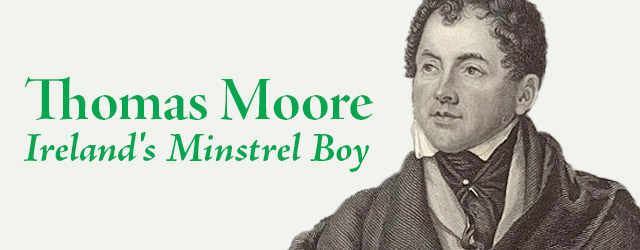By Msgr. Francis A. Carbine
On St. Patrick’s Day, 1952, I stood on the steps of his Cathedral, New York City, as a parade watcher. I was in high school. I can yet hear the bagpipes echoing off the walls of the stone canyon that is Fifth Avenue. The song that I so well recall these 70 years later is Thomas Moore’s, “The Minstrel Boy.”
Lyrics tell the story of a young “warrior bard” who died fighting for Ireland. England, however, is never mentioned. He slings his harp onto his back and takes up his father’s sword. As the boy falls in death, he smashes his harp because “The songs were made for the pure and free./They shall never sound in slavery.”
This bracing elegy is bagpipers favorite on St. Patrick’s Day. “Minstrel Boy” emphatically endorses Ireland’s freedom. Moore’s lyrics are also a universal lament for countless young soldiers who have died in wars. The Vietnam Memorial in Washington lists 58,300 names – most of whom died young. Killed in action were three Gold Star alumni of Cardinal O’Hara High School, Springfield: Charles F. McGrath, age 20; James J. McCaffrey, age 20; and Johnny J. Miller, age 22.
Dating from 1813, “The Minstrel Boy” was played by pipers serving Irish Brigades in the American Civil War. In 2001, this song accompanied funeral of Father Mychal Judge, Fire Chaplain and first official victim of bombing of New York’s Trade Center.
Thomas Moore was born in Dublin, 1779, and attended Trinity College. As a Catholic he was not permitted to receive scholastic prizes. He knew Lord Edward Fitzgerald, architect of failed rebellion in 1798. After receiving 500 lashes, he died in prison.
Moore was also schoolmate of Robert Emmet, Irish patriot hanged and then beheaded in Dublin, 1803. Some 30,000 Irishmen were subsequently killed or transported to Australia.
Moore daringly wrote biography of Fitzgerald, and bravely composed “O Breathe Not His Name” in memory of Robert Emmet. His fiancé, Sarah Curran, subsequently married and died in Italy. “She is far from the land where her young hero sleeps.”
Ireland in early years of 19th century was described by Moore in his “Journal” as a place of “misery and filth … degradation and enslavement of the Irish people.” Goal of Queen Elizabeth I had been to reduce Ireland to ”carcasses and ashes.” A reward of five pounds was set on the head of a “romish priest – exactly the sum for the head of a dead wolf.”
King George III refused any accommodation to Catholics lest he violate his Coronation Oath in which he pledged to maintain “the Protestant Reformed Religion.” [This anachronistic oath will be taken by King Charles III.]
Irishmen, however, had caught the spirit of the French Revolution, 1789. The Irish yearning for independence surged. In 1824. Moore anonymously published “Memoirs of Captain Rock” attacking with biting realism the degradation of Ireland by English occupiers.
Moore, an early romantic poet, invited Irish people to reflect on the era when Brian Boru was High King, St. Malachy wore his collar of gold, and the Red Branch Knights of Ulster performed deeds of unrivalled greatness. Moore celebrated the age before “the emerald gem of the Western world was set in the crown of the stranger.”
Culturally deprived, Irishmen may not have been able to read, but they were able to sing. And what they sang were the lyrics of Thomas Moore. Between 1808 and 1834, he published 130 songs — “Irish Melodies.” He used ancient tunes. The voice of Ireland, long repressed, began to be heard. The harp that for centuries had hung mute on Tara’s walls, sounded again.
Some songs were forthrightly sentimental: “Tis the last rose of summer left blooming alone…”; and “Sad, silent and dark, be the tears that we shed…” Sentiment, however, also has validity: “The heart that has truly loved, never forgets!”
Patriotism, often tempered with nostalgia, animated many lyrics: “Remember the glories of Brian the Brave…But enough of the glory remains on each sword/to light us to victory yet!” Tara, dwelling of Ireland’s High Kings, recalled “the chiefs and ladies bright” who assembled there “in the pride of former days.” Seamus Heaney later spoke of Moore’s “sentimental nationalism.”
However, with Tom Moore, Wolfe Tone and Daniel O’Connell Irish nationalism came alive! Eamon De Valera acknowledged that “Thomas Moore kept the lamp of hope burning in millions of Irish hearts.” Moore’s bronze bust stands in Central Park, New York.
Moore spent most of his adult life in England where his talent earned him access to estates of the English elite. Lord Moira, proprietor of Donington Park, introduced Moore to the Prince of Wales. Moore also met Thomas Jefferson, Walter Scott, Washington Irving, Lord Byron, and other celebrities.
One of his best loved melodies is “Believe Me If All Those Endearing Young Charms.” John McCormick sang this in his concerts. John Ford used melody in film, “The Informer.” Mary Black, Dublin singer and harpist, held audiences spell-bound with this song to love’s enduring power.
Brian Friel opened his play, “The Home Place,” with ethereal music of “Oft in the Stilly Night.” Later in the play characters exuberantly dance to “Young May’s moon is beaming, Love.” Both songs are “Irish Melodies.”
The first publication of “Irish Melodies” was illustrated with an Irish harp, long the emblem of Ireland. [And today the Guinness trademark!] On Moore’s tombstone his words are inscribed: “Dear Harp of my country! in darkness I found thee . . . And gave all thy chords to light, freedom and song.”


Excellent article
Exquisite article about Ireland’s greatest composer of lyrical song. I think Seamus Heaney only got it partially right when he described Moore’s lyrics & songs as “sentimental nationalism.” His lyrics go to the very soul of the Irish nation – a people’s love of their island home and their centuries long search for Ireland’s freedom. Very well written article and inspirational too!